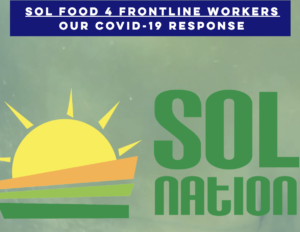Environmental Justice is Racial Justice
Guest blog by Climate Ambassador Nakisa Glover, of SolNation:
Environmental Justice is Racial Justice and there is an extensive history of environmental racism connecting the two. The most impacted people have always been marginalized. This month we explore the connection between Environmental Justice and Racial Justice.

Environmental racism is the disproportionate impact of environmental hazards on people of color. According to Dr. Robert Bullard, contributing factors include the “lack of economic and political clout.” Seeking to address the inequities of environmental protection residents, environmentalists, and civil rights activists protested the construction of a polychlorinated biphenyl (PCB) landfill in Warren County, North Carolina in 1982, catalyzing the Environmental Justice Movement. The predominantly Black community of Warren County, with a median household income under $7000, lost its battle to stop the construction of a toxic landfill. This is an early example of environmental racism so blatant that it gained national attention and reinvigorated of the Environmental Justice Movement. In many ways, this series of events, led to my own introduction and understanding of both race and my place in the natural world around me.
I don’t know exactly when the term “environmental racism” entered my consciousness. It’s upsetting that it wasn’t there earlier. After all, I focused on biology, chemistry and African American studies in college, and yet it wasn’t until I began working as a community organizer that I began to know and understand the term. Why did it take so long? Why were we, as Black families, as Black students, not talking about this at the kitchen table? At school? In our social circles?

Racism is, as Kareem Abdul-Jabar wrote, as pervasive as “dust in the air.” Yet, even though it shows up in our soil, water and every breath we take, it seldom makes it to prominence in our conversations to the level at which it impacts our existence. It is quite possible that I heard the term before my involvement as a community organizer, but it did not stick until I’d lived it.
There is a failure to translate. When we talk in terms of the ways environmental racism manifests, we must go beyond theory into a place of lived experience. It’s the stench of rural North Carolina pig farms with their rancid lagoons of waste, forcing you to roll up your windows as you pass. It’s the metallic sting in the back of the throat, threatening to make you choke whenever you drive through a certain part of town, right near the industrial park or “the plant.” It’s the nagging anxiety of never knowing if your water is truly safe to drink, even after boiling it, because of Gen X, coal ash, and other carcinogens you know are likely present. It’s the Title I schools in Black communities where children can’t drink from classroom water fountains because lead tests came back positive.
To be honest, I struggled with this topic. What can I say that hasn’t already been said about racial justice? The deeper I delved into this topic, the more I wanted to amplify others moving this conversation. I invite you to check out our latest Sol Story featuring Colette Pichon-Battle, and when you are done, listen to the 1619 podcast hosted by Nikole Hannah-Jones. Read Faces at the Bottom of the Well by Derrick Bell, check out the full Environmental Justice/Environmental Racism resource, attend the #Katrina15, and enjoy this month’s specially curated mixtape Environmental Justice Is… Vol 4 Racial Justice.

Nakisa Glover is the Executive Director of Sol Nation in Charlotte, NC. She has a passion for advocacy and contributing positively to the community, working to raise awareness about threats as well as key climate issues and to advocate for real SOLutions. In her role as Executive Director, she provides vision for Sol Nation and the pathways to solutions that can help communities thrive.
